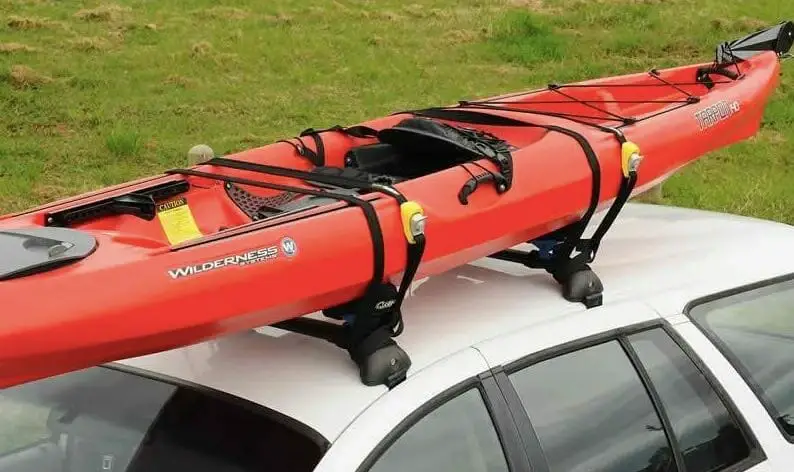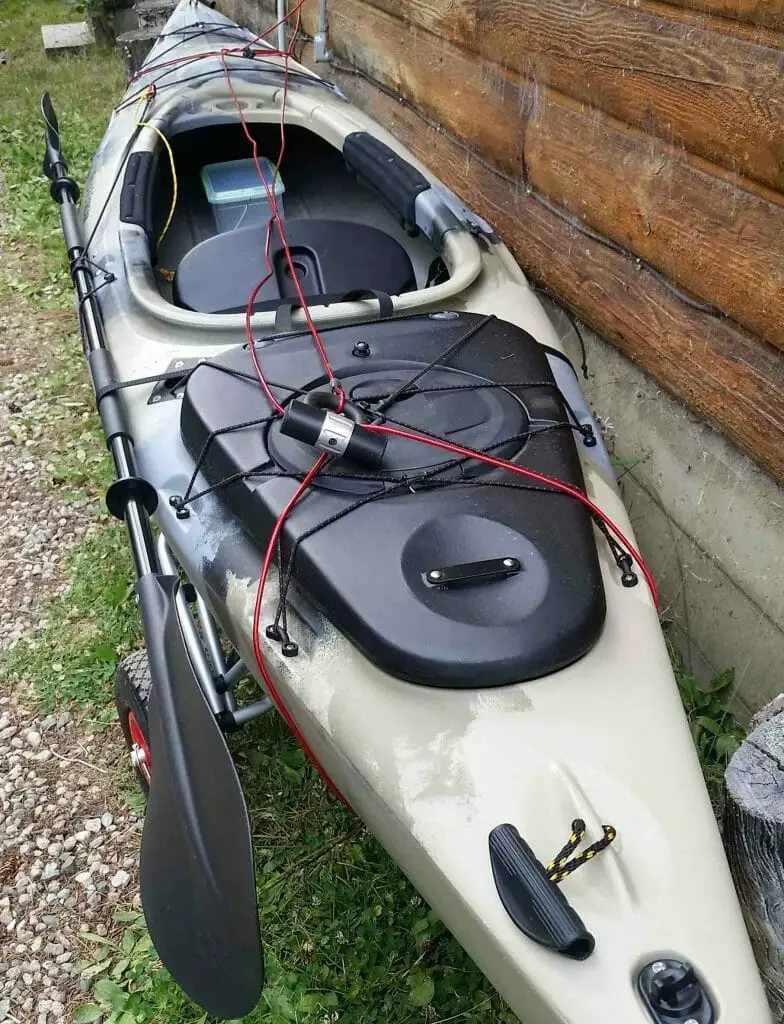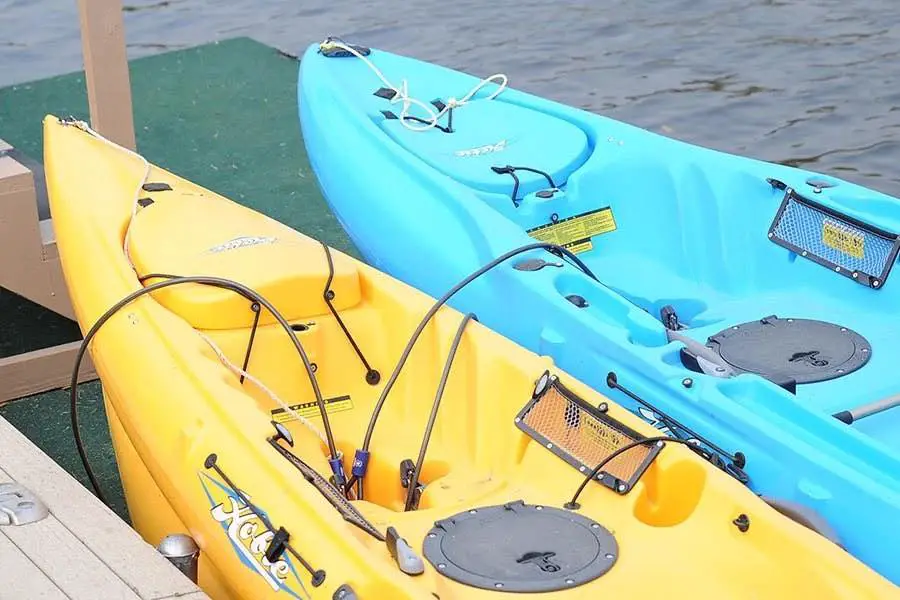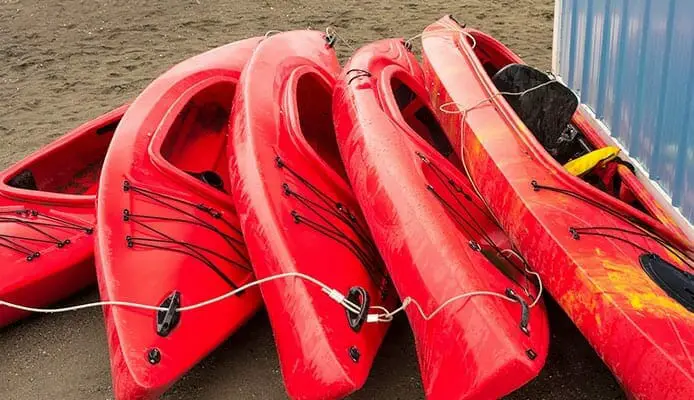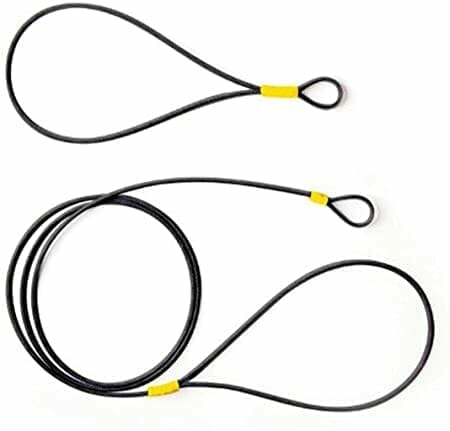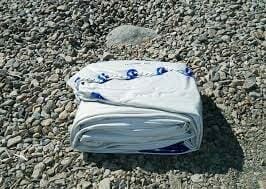How To Lock Up A Kayak (The Safe and Secure Way)

Whether you own a personal Kayak or run a Kayaking business, you need to know how to properly lock up a Kayak to avoid theft. It can be a bit tricky to secure a Kayak, as these boats don’t come with a built-in locking mechanism.
There are various hacks to locking a Kayak indoors, but if you want to lock it outdoors, then you’ve got to get your creative juices flowing. We’ve got your back on that front.
The best way to lock up a kayak is to use a padlock and some type of rope. Read on to know some neat tricks to secure your Kayak outdoors.
How To Lock Up Your Kayak
Locking up a Kayak is important if you don’t want it to get stolen, kayaks are expensive and often the biggest targets of thefts. Here are all the ways you can lock up all kinds of Kayaks, in all sorts of spaces, including at home and outdoors.
On-Road
If you’re going to a remote destination for your Kayaking trip, you might need to make some transport arrangements for your Kayak too. Obviously, the passenger seat is out of the question, so you’ve got to get your hands on some tie-down locks to secure the Kayak on the roof rack of your car. Carrying a Kayak on top of your vehicle without any locks can damage the Kayak beyond repair due to the crashing wind. You may check the best kayak roof rack if you need one.
Not to mention, there’s the added risk of your Kayak being flung out of the rack. So don’t take the risk of NOT securing the Kayak with a cable when you’re transporting it on your car. A simple cycle lock would do the trick as well. This will also protect the Kayak from theft if you’re making stops along the way to the site of Kayaking.
At Home
Ideally, Kayaks should be stored indoors to protect their exterior from harmful elements such as moisture, rain, and snow. To store it inside the house is just perfect, but you need to take some extra measures to secure it inside. The best place for a Kayak to be stored on a garage or a shed. Or if it’s inside the house that you’re considering, you can buy one of those wall-mount racks, or hang it on a suspension system. (1)
However, if all these storage options are unavailable to you, due to lack of space inside the house for a rack, and the absence of a garage or shed, then you can consider fastening the Kayak against a sturdy tree. You can loop a rope around the Kayak and the tree to anchor the boat to it, then secure it using a padlock.
Loop the rope around the handles of the Kayak, or the scupper plug holes to secure it properly. To keep it safe from harsh weather conditions, you could also cover the Kayak with a tarp. This would also keep the Kayak out of the sight of potential thieves. You don’t have to invest in a sophisticated locking system, just a strong enough rope, and a Kayak lock would do the trick. Just make sure you fasten it to the tree, or a permanent structure properly, and you should be good.
Away From Home
If you’re a long way from home, we’d advise you to fasten your Kayak to your car’s roof rack. But if you’re not taking your vehicle with you, and considering walking to the campsite with your Kayak on foot, then we’ve got some new things to worry about. A witty thief could easily slip your Kayak from under your nose at a bustling campsite if you’re not careful. But if you play your cards right, then you can keep your Kayak safe without guarding it 24/7.
If it’s a hard-shell Kayak that you’ve brought with you on the trip, then you can secure your Kayak to a sturdy structure nearby using a rope and a padlock. A cable lock would be a perfect thing to buy for this occasion. Browse the campsite for a sturdy tree, a dock, or even a log that could keep your boat safe.
If it’s an inflatable kayak that you have, then we believe that you won’t have any problem, as you could simply deflate the Kayak and stash it inside your tent. Inflatable Kayaks are extremely travel-friendly.
Securing Several Sit-on-top and Sit-inside Kayaks
If you run a commercial kayaking business, chances are you’d have more than one Kayak to keep safe. Buying separate padlocks for each Kayak can be really expensive. One of the hacks to securing multiple sit-on-top Kayaks is bundling them together, using a Kayak cable lock, and looping it around a stationary anchor point, such as a tree, or a pole.
You can loop it around the boat’s scupper holes and secure it with the anchor point.
You can secure the sit-inside Kayaks in the same way, by tying them up with other Kayaks, although it could prove to be a bit difficult as sit-inside Kayaks don’t have scupper holes to loop the cables through. You could wind the wire through the metal loops that are attached to the deck of the Kayak if need be. For this, you’d need a different kind of cable, a smaller one to wind through the small space underneath the loops.
Locking an Inflatable Kayak
Locking up an inflatable Kayak is no trouble at all. They are very travel-friendly and can be locked up inside your tent or vehicle once you deflate it. However, if you use your inflatable Kayak often, you might not be inclined towards deflating it after each Kayaking trip. In this case, you could secure the inflatable Kayak to your vehicle’s roof rack using a Kayak cable lock, the same one we used for the hard kayaks. Make sure you lock the inflatable Kayaks really well. If you leave this sort of Kayak unattended and unsecured, a thief would have no problem in carrying away such a lightweight Kayak.
Additional Tips To Keep Your Kayak Safe
Locking your Kayak is the bare minimum you can do to keep it safe. Here are some additional tips that you can follow through to give your Kayak extra security, so you can have peace of mind.
Purchase Insurance For Your Kayak
Just like every other asset you own, getting insurance for your Kayak is one of the smartest decisions you will make. While in most cases, a homeowner’s insurance policy also covers Kayaks, there’s no harm in double-checking. If your Kayak needs a boat’s insurance of its own, browse through all the insurance options before paying any money. (2)
Research the policy terms beforehand, as, in a lot of cases, the policy only covers a limited amount of money. This means, if the cost of your Kayak exceeds the insurance limit, then you’d have to buy a watercraft insurance policy. In any case, getting your Kayak insured is recommended. This way, even if something goes wrong despite all the precautions, you’d have your insurance money to fall back on.
Keep The Kayak Out of Sight
If your Kayak is sitting idly in an open space, with no cover whatsoever, it’s basically like the Kayak is inviting thieves to steal it. You don’t want people to know that you’ve got a fantastic-looking Kayak sitting outside of your house or your tent. If you don’t have a garage or shed storage options, the least you can do is to cover the Kayak with a tarp to hide it from plain sight.
If the Kayak is under wraps, fewer people would be tempted to put their neck on the line and try to steal it. Half the people won’t even be able to identify the wrapped-up Kayak. Therefore, once you’ve locked up to your kayak with a Kayak lock, cover it to keep it out of people’s sight, and subsequently, their minds. This would also protect your Kayak from unfavorable weather conditions.
Engrave Hull Identification Number At The Bottom (HIN)
Imagine if your car got stolen, what would be the first thing you’d do when you notice its disappearance. Let the authorities know about the car plate’s number perhaps? That’s pretty much what any sensible person would do if their vehicle gets lost. Well, that’s what you must do when your Kayak goes missing as well. The only difference is, instead of a number plate, the kayak boats have a hull identification number (HIN). It is a 12-digit unique identification code that is stamped on every Kayak.
The HIN is what helps us identify between different Kayaks. All the Kayaks manufactured after 1972 have a HIN engraved on the boat. When you purchase a new Kayak, note its HIN on a piece of paper, or save it on your phone. If your Kayak goes missing, you can inform the authorities of its HIN, and they’d use the number to locate your property.
For extra measure, you can engrave the HIN below the Kayak yourself too. The first thing any smart thief would do is remove the HIN as soon as they nab your Kayak. But perhaps they won’t make the effort of scanning the whole boat for other engravings. If you can find a less noticeable spot on your Kayak, stamp a number or initials for identification.
How To Lock Up Your Kayak – Bottom Line
The point of this whole post is to inform you to never leave your Kayak unlocked, whether you’re at home, or at a campsite. If you’re not careful, you could lose your Kayak as soon as you turn your head. At the same time, you want to ensure that you don’t expose your Kayak to any harmful weather elements. Hence, while coming up with a protection system for your Kayaks, lock it up in such a way that your boat gets protection from both, weather elements, and thievery.
If you’ve already spent a lot of money on a Kayak, we’d advise you to invest a bit more in buying a good-quality padlock as well. Cable locks are not that expensive and could help you protect your Kayak.
Here are other guides below that you may need. Until our next kayak article!
Reference
(1) harmful elements – https://link.springer.com/chapter/10.1007/978-94-017-8965-3_11
(2) insurance options – https://www.investopedia.com/financial-edge/0212/4-types-of-insurance-everyone-needs.aspx

